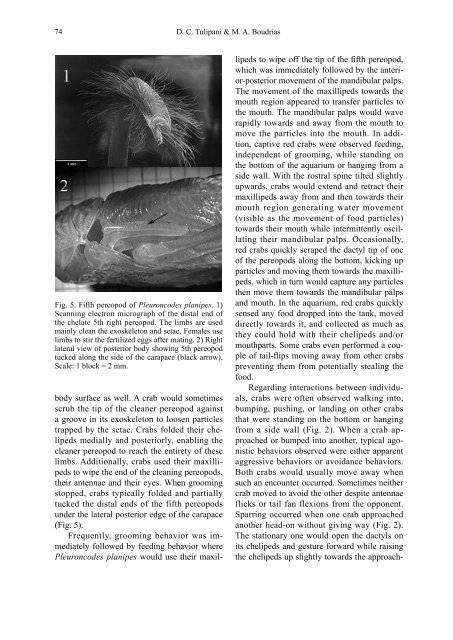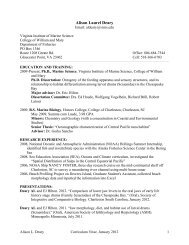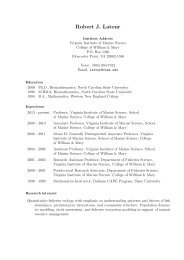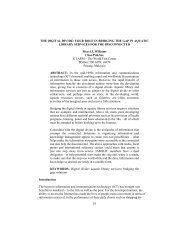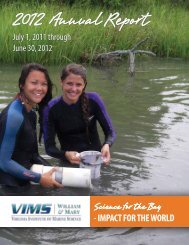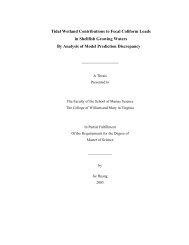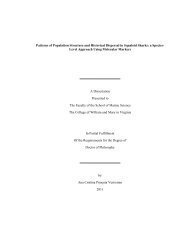74 D. C. Tulipani & M. A. BoudriasFig. 5. Fifth pereopod <strong>of</strong> <strong>Pleuroncodes</strong> <strong>planipes</strong>. 1)Scanning electron micrograph <strong>of</strong> <strong>the</strong> distal end <strong>of</strong><strong>the</strong> chelate 5th right pereopod. The limbs are usedmainly clean <strong>the</strong> exoskeleton and setae. Females uselimbs to stir <strong>the</strong> fertilized eggs after mating. 2) Rightlateral view <strong>of</strong> posterior body showing 5th pereopodtucked along <strong>the</strong> side <strong>of</strong> <strong>the</strong> carapace (black arrow).Scale: 1 block = 2 mm.body surface as well. A <strong>crab</strong> would sometimesscrub <strong>the</strong> tip <strong>of</strong> <strong>the</strong> cleaner pereopod againsta groove in its exoskeleton to loosen particlestrapped by <strong>the</strong> setae. Crabs folded <strong>the</strong>ir chelipedsmedially and posteriorly, enabling <strong>the</strong>cleaner pereopod to reach <strong>the</strong> entirety <strong>of</strong> <strong>the</strong>selimbs. Additionally, <strong>crab</strong>s used <strong>the</strong>ir maxillipedsto wipe <strong>the</strong> end <strong>of</strong> <strong>the</strong> cleaning pereopods,<strong>the</strong>ir antennae and <strong>the</strong>ir eyes. When groomingstopped, <strong>crab</strong>s typically folded and partiallytucked <strong>the</strong> distal ends <strong>of</strong> <strong>the</strong> fifth pereopodsunder <strong>the</strong> lateral posterior edge <strong>of</strong> <strong>the</strong> carapace(Fig. 5).Frequently, grooming behavior was immediatelyfollowed by feeding behavior where<strong>Pleuroncodes</strong> <strong>planipes</strong> would use <strong>the</strong>ir maxillipedsto wipe <strong>of</strong>f <strong>the</strong> tip <strong>of</strong> <strong>the</strong> fifth pereopod,which was immediately followed by <strong>the</strong> anterior-posteriormovement <strong>of</strong> <strong>the</strong> mandibular palps.The movement <strong>of</strong> <strong>the</strong> maxillipeds towards <strong>the</strong>mouth region appea<strong>red</strong> to transfer particles to<strong>the</strong> mouth. The mandibular palps would waverapidly towards and away from <strong>the</strong> mouth tomove <strong>the</strong> particles into <strong>the</strong> mouth. In addition,captive <strong>red</strong> <strong>crab</strong>s were <strong>observed</strong> feeding,independent <strong>of</strong> grooming, while standing on<strong>the</strong> bottom <strong>of</strong> <strong>the</strong> aquarium or hanging from aside wall. With <strong>the</strong> rostral spine tilted slightlyupwards, <strong>crab</strong>s would extend and retract <strong>the</strong>irmaxillipeds away from and <strong>the</strong>n towards <strong>the</strong>irmouth region generating water movement(visible as <strong>the</strong> movement <strong>of</strong> food particles)towards <strong>the</strong>ir mouth while intermittently oscillating<strong>the</strong>ir mandibular palps. Occasionally,<strong>red</strong> <strong>crab</strong>s quickly scraped <strong>the</strong> dactyl tip <strong>of</strong> one<strong>of</strong> <strong>the</strong> pereopods along <strong>the</strong> bottom, kicking upparticles and moving <strong>the</strong>m towards <strong>the</strong> maxillipeds,which in turn would capture any particles<strong>the</strong>n move <strong>the</strong>m towards <strong>the</strong> mandibular palpsand mouth. In <strong>the</strong> aquarium, <strong>red</strong> <strong>crab</strong>s quicklysensed any food dropped into <strong>the</strong> tank, moveddirectly towards it, and collected as much as<strong>the</strong>y could hold with <strong>the</strong>ir chelipeds and/ormouthparts. Some <strong>crab</strong>s even performed a couple<strong>of</strong> tail-flips moving away from o<strong>the</strong>r <strong>crab</strong>spreventing <strong>the</strong>m from potentially stealing <strong>the</strong>food.Regarding interactions between individuals,<strong>crab</strong>s were <strong>of</strong>ten <strong>observed</strong> walking into,bumping, pushing, or landing on o<strong>the</strong>r <strong>crab</strong>sthat were standing on <strong>the</strong> bottom or hangingfrom a side wall (Fig. 2). When a <strong>crab</strong> approachedor bumped into ano<strong>the</strong>r, typical agonisticbehaviors <strong>observed</strong> were ei<strong>the</strong>r apparentaggressive behaviors or avoidance behaviors.Both <strong>crab</strong>s would usually move away whensuch an encounter occur<strong>red</strong>. Sometimes nei<strong>the</strong>r<strong>crab</strong> moved to avoid <strong>the</strong> o<strong>the</strong>r despite antennaeflicks or tail fan flexions from <strong>the</strong> opponent.Sparring occur<strong>red</strong> when one <strong>crab</strong> approachedano<strong>the</strong>r head-on without giving way (Fig. 2).The stationary one would open <strong>the</strong> dactyls onits chelipeds and gesture forward while raising<strong>the</strong> chelipeds up slightly towards <strong>the</strong> approach-
<strong>Behaviors</strong> <strong>of</strong> <strong>Pleuroncodes</strong> <strong>planipes</strong> 75ing <strong>crab</strong>. This type <strong>of</strong> gesturing usually resultedin <strong>the</strong> approaching <strong>crab</strong> changing directions.Sparring between males also occur<strong>red</strong> whenone male approached a female that was beingguarded by ano<strong>the</strong>r male ei<strong>the</strong>r prior to or justafter mating.DISCUSSION<strong>Pleuroncodes</strong> <strong>planipes</strong> have been describedas dividing <strong>the</strong>ir time between <strong>the</strong> benthos during<strong>the</strong> day and <strong>the</strong> epi<strong>pelagic</strong> zone to feed atnight (Boyd, 1962; Blackburn, 1977). However,<strong>the</strong> <strong>crab</strong>s were also found in large surfaceswarms during <strong>the</strong> day (Boyd, 1967; Aurioles-Gamboa, 1992) and are conside<strong>red</strong> <strong>the</strong> mostabundant nektonic organism <strong>of</strong>f sou<strong>the</strong>rn BajaCalifornia waters (Blackburn & Thorn, 1974).When <strong>the</strong> <strong>crab</strong>s were initially collected forthis study, <strong>the</strong>y were small (standard carapacelength < 32 mm), which corresponded with <strong>the</strong><strong>pelagic</strong> phase <strong>of</strong> <strong>the</strong>ir life cycle (Boyd, 1967);<strong>the</strong>y floated frequently and could not walk wellwhen stranded on <strong>the</strong> beaches. However, afterbeing introduced into <strong>the</strong> aquarium with numeroussurfaces to rest on, P. <strong>planipes</strong> began toexhibit more benthic behaviors. Once in captivity,<strong>the</strong> <strong>red</strong> <strong>crab</strong>s seemed to grow quickly andmany <strong>of</strong> those collected in April 2002 moltedafter only a month in <strong>the</strong> aquarium. Over time,<strong>the</strong>y adopted a mainly benthic lifestyle withintermittent periods <strong>of</strong> swimming, hovering andpassive sinking. This change in <strong>the</strong> <strong>red</strong> <strong>crab</strong>s’behavior from planktonic to mostly benthic wasalso <strong>observed</strong> <strong>of</strong> <strong>the</strong> captive <strong>crab</strong>s kept in anaquarium by Boyd (1962).Boyd (1967) described <strong>red</strong> <strong>crab</strong>s as voraciouseaters, with an omnivorous diet. This hasbeen supported by observations in <strong>the</strong> watercolumn <strong>of</strong>f sou<strong>the</strong>rn Baja California where <strong>red</strong><strong>crab</strong>s feed on phytoplankton and zooplankton(Longhurst, 1967) and even ingest particulateorganic matter when on <strong>the</strong> ocean bottom(Aurioles-Gamboa & Pérez-Flores, 1997). Red<strong>crab</strong>s moved <strong>the</strong>ir maxillipeds and <strong>the</strong>n <strong>the</strong>irmandibular palps every few seconds ingestingfood particles or moving water towards<strong>the</strong> mouth. Similar limb motions have been<strong>observed</strong> in palinurid lobsters, and many o<strong>the</strong>rmalacostracan crustaceans, where <strong>the</strong>y flick<strong>the</strong>ir antennules and mouthpart appendages andcreate convective flows <strong>of</strong> water that facilitate<strong>the</strong> tracking <strong>of</strong> <strong>the</strong> chemical signatures <strong>of</strong> food(Goldman & Patek, 2002).Additional limb motion, possibly related t<strong>of</strong>eeding behaviors, occur<strong>red</strong> frequently when<strong>the</strong> <strong>red</strong> <strong>crab</strong>s groomed <strong>the</strong>mselves. In contrastto some species <strong>of</strong> brachyuran spider <strong>crab</strong>s(Macropodia spp.) that attach pieces <strong>of</strong> algaeto <strong>the</strong>ir carapace or those that have modifiedpereopods to hold sponges to <strong>the</strong>ir bodies forcamouflage (Dromidia spp.) (Warner, 1977;Ross, 1983), <strong>Pleuroncodes</strong> <strong>planipes</strong> spent timemeticulously cleaning <strong>the</strong>ir exoskeleton <strong>of</strong> particlesthat had adhe<strong>red</strong> to it with <strong>the</strong>ir chelatefifth pereopods. Bauer (1989) listed numeroussources <strong>of</strong> fouling particles, such as sediment,unicellular algae, and parasites that can accumulateon <strong>the</strong> exoskeleton <strong>of</strong> aquatic crustaceansand negatively impact normal functions<strong>of</strong> sensory, respiratory and locomotory behaviors.Accumulated debris on <strong>the</strong> exoskeleton <strong>of</strong><strong>the</strong> <strong>red</strong> <strong>crab</strong> may be akin to fouling organismson <strong>the</strong> hull <strong>of</strong> a ship (Bauer, 1989). If <strong>the</strong> exoskeletonwas not frequently cleaned betweenmolts, <strong>the</strong> fouling particles would build up,eventually modifying <strong>the</strong> natural streamlining<strong>of</strong> <strong>the</strong> <strong>red</strong> <strong>crab</strong>’s carapace, pereopods, abdomenand tail-fan with <strong>the</strong>ir associated setae.Maintaining <strong>the</strong> exoskeleton appea<strong>red</strong> to be animportant function that may enhance <strong>the</strong> <strong>pelagic</strong><strong>red</strong> <strong>crab</strong>s’ swimming efficiency by <strong>red</strong>ucing<strong>the</strong> drag along <strong>the</strong> body (Tulipani, 2005).Fur<strong>the</strong>rmore, <strong>the</strong>se accumulated particles werea food source for <strong>the</strong> <strong>red</strong> <strong>crab</strong>s.When <strong>red</strong> <strong>crab</strong>s interacted with each o<strong>the</strong>rin <strong>the</strong> aquarium, <strong>the</strong>y prefer<strong>red</strong> keeping somedistance between each o<strong>the</strong>r, a common behavioramong <strong>crab</strong>s which allows <strong>the</strong>m to avoidone ano<strong>the</strong>r (Warner, 1977; Salmon & Hyatt,1983). When distance was not maintained, agonisticbehaviors (gesturing with chelipeds withdactyls abducted or fighting) and avoidancebehaviors (brief tail-flips away) were <strong>observed</strong><strong>of</strong> <strong>red</strong> <strong>crab</strong>s and have been similarly describedfor o<strong>the</strong>r decapod <strong>crab</strong> species (Pilumnus sp.,


